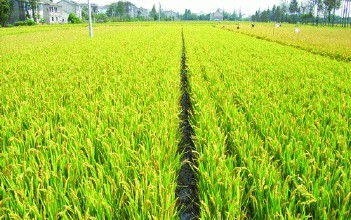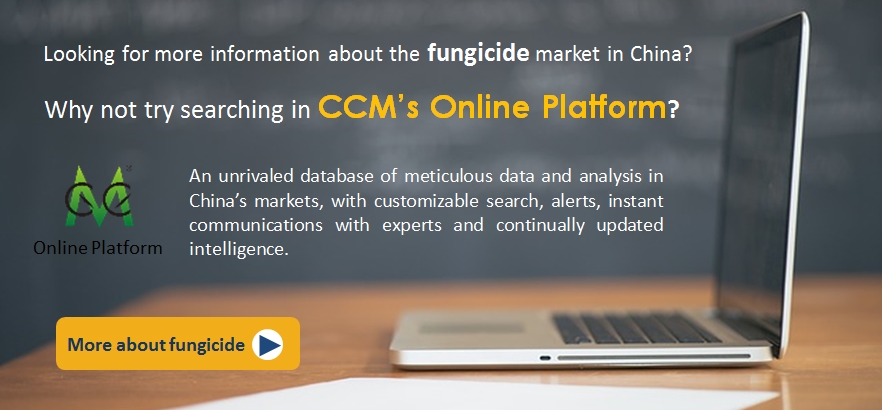Recent years has witnessed increasingly
heavy occurrence of bacterial diseases in China. In particular, things even got
worse affected by the extreme weather like typhoons and storms as well as high
temperature and humidity in the past two years.

Source: Baidu
For long, streptomycin was widely used for controlling and preventing bacterial
diseases. Yet, after 2016, it will be banned in China. In this context, many
other bacterial products compete for the large market share used to be taken up
by streptomycin. Changes are expected to take place in the domestic bacterial
fungicide market in the near future.
So, what are the main bacterial fungicides in the market to date? And which are
the leading producers?
According to the Institute for the Control of Agrochemicals, Ministry of
Agriculture, major bacterial fungicides registered in China include thiediazole
copper, bismerthiazol, paenibacillus polymyza, pseudomonas fluorescens, bacillus
subtilis, chloroisobromine cyanuric acid, trichloroiso cyanuric acid,
zhongshengmycin, ethylicin, kasugamycin, shenqinmycin, copper hydroxide, copper
oxychloride, bordeaux mixture, copper calcium sulphate, copper (succinate +
glutarate + adipate), copper acetate, Zn-thiodiazole and saisentong.
It is notable that both domestic and overseas pesticide manufacturers compete
for larger sales in the Chinese bacterial fungicide market. According to
complete statistics, leading enterprises were:
-
Domestic: Zhejiang Longwan Chemicals Co.,
Ltd. (thiediazole copper), Zhejiang Xinnong Chemical Co., Ltd.
(Zn-thiodiazole), Nanjing Nannong Agriculture Science and Technology
Development Co., Ltd. (chloroisobromine cyanuric acid), Hunan Wanjiafeng
Technology Co., Ltd. (copper rosinates), Jiangxi Heyi Chemical Co., Ltd.
(copper oxychloride), Zhejiang Hisun Chemical Co., Ltd. (oxine-copper) and
Yanbian Chunlei Biologicals Co., Ltd. (kasugamycin)
-
Overseas: DuPont (copper hydroxide), Nufarm
Limited (copper hydroxide) and Industrias Químicas del Vallés, S.A. (copper
calcium sulphate)
Specifically, common bacterial fungicides
are categorised as follows:
1. Organic copper
-
Advantage: good efficacy, compatibility and
high safety; little phytotoxicity
-
Application: long duration for use, even
applicable during flowering and early-fruiting periods; wide spectrum,
including rice, vegetables, melons and fruits
Given these features, this kind of fungicides develops rapidly in the market,
even though it has not been launched for long. Moreover, given its high value
for research, organic copper fungicides are promising in the market. In
particular, thiediazole copper, a member of this series, is widely used now.
2. Inorganic copper
-
Advantage: high efficiency and low price
-
Disadvantage: easy to cause phytotoxicity;
not applicable during flowering and early-fruiting periods or just in
restricted amount; poor efficacy; difficult to be applied on rice
As a traditional product, inorganic copper fungicides show week profitability
and producers have to face intense competition in this market. Notably, some
enterprises also launched new inorganic copper formulations that show strong
fungicidal activity, long-lasting efficacy and safety to crops.

3. Antibiotics
-
Advantage: widely used; systemic; good
efficacy
-
Disadvantage: strong resistance as the kind
of products has been used for long; low safety as residues may pose risks to
human life
-
Application: specific usage methods should
be chosen based on crop diseases
So far, antibiotic fungicides are restricted by national policies on
registration, residue limits and antibiotics abuse. In particular,
streptomycin, a typical product in this family, will be banned for registration
after 2016.
4. Thiazole
Thiazole fungicides were first used for the control and prevention of rice
bacterial leaf blight which is no longer a serious disease now. As the planting
area of cash crops expands and bacterial diseases strike more often in recent
years, the kind of products becomes popular again in the market.
The products have limited efficacy against bacteria in soil given the fact that
they show no fungicidal activity when separated from crops.
5. Microbial formulations
-
Advantage: environmentally friendly; able
to improve soil quality; safety to crops. animals and human
-
Disadvantage: low recognition among farmers
So far, these innovative formulations are popular in production bases for
pollution-free vegetables, exported vegetables and organic food.
Typical bacterial fungicides in China
|
No.
|
Category
|
Typical fungicide
|
|
1
|
Organic
copper
|
Thiediazole
copper, zinc tetramminosulfate, copper rosinates, copper (succinate +
glutarate + adipate), cuppric nonyl phenolsulfonate, oxine-copper,
saisentong, etc.
|
|
2
|
Inorganic
copper
|
Copper
hydroxide, cuprous oxide, bordeaux mixture, copper oxychloride, etc.
|
|
3
|
Thiazole
|
Bismerthiazol,
Zn-thiodiazole, etc.
|
|
4
|
Microbial
formulations
|
Paenibacillus
polymyza, pseudomonas fluorescens, bacillus subtilis, zhongshengmycin,
kasugamycin, etc.
|
Source: Institute for the Control of
Agrochemicals, Ministry of Agriculture
Bacterial diseases, caused by bacteria or
fungi, are often induced by high temperature and humidity.
-
Symptom: wilting, rotting and perforating;
stench mucus exuding from infected areas in wet weather
-
Category: leaf spot, leaf blight, leaf
wilt, canker, rot and deformity
In reality, common bacterial diseases include cucumber angular leaf spot,
pepper bacterial wilt, tomato bacterial wilt, Chinese cabbage bacterial soft
rot, potato ring rot, citrus canker, peach bacterial shot hole, fruit tree
crown gall, etc.
This article comes from Fungicides China News 1610, CCM

About CCM:
CCM is the leading market intelligence provider for China’s
agriculture, chemicals, food & ingredients and life science markets. Founded in 2001, CCM offers a
range of data and content solutions, from price and trade data to industry
newsletters and customized market research reports. Our clients include Monsanto,
DuPont, Shell, Bayer, and Syngenta. CCM is a brand of Kcomber Inc.
For more
information about CCM, please visit www.cnchemicals.com or get in touch with us
directly by emailing econtact@cnchemicals.com or calling
+86-20-37616606.
Tag: fungicides